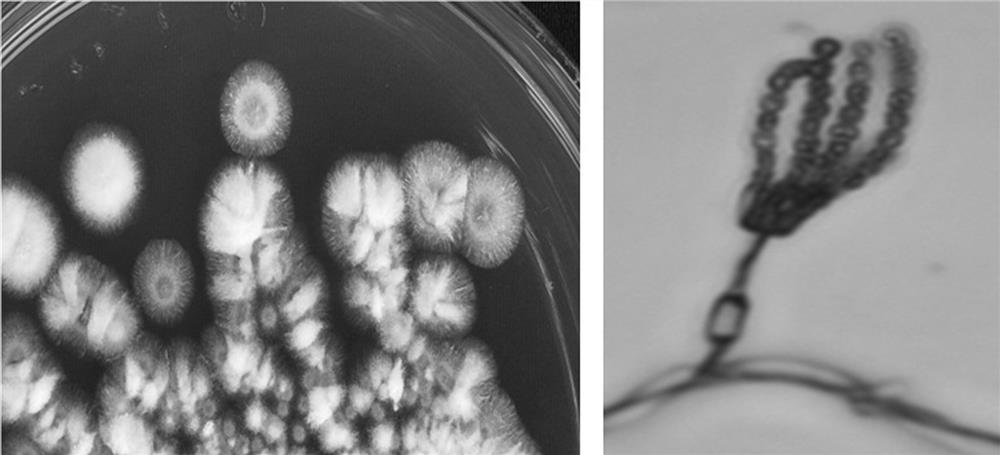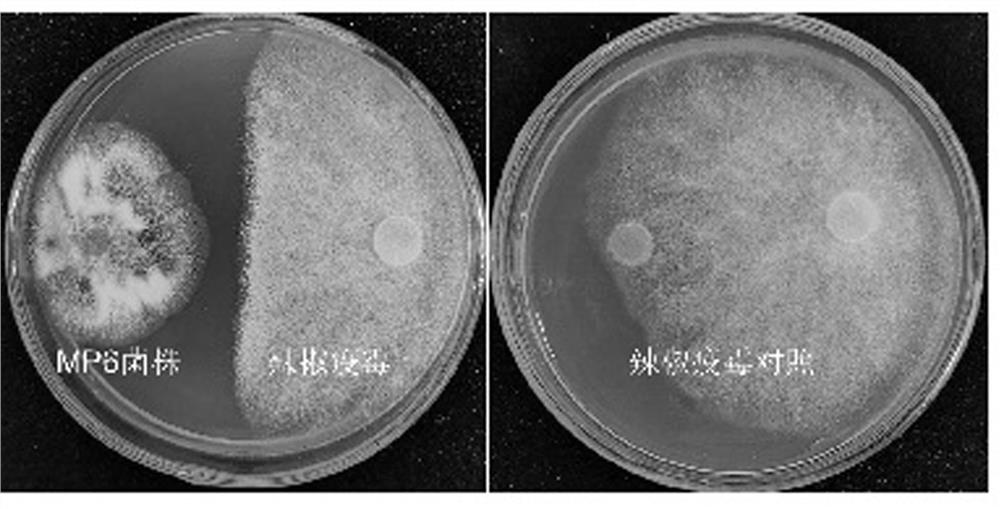A strain of Penicillium bilaii mp6 with antibacterial effect and its application
A technology of Penicillium baileyi and bacteriostatic effect, applied in the field of microorganisms, can solve problems such as affecting the sustainable and healthy development of agriculture, destroying ecological balance, environmental pollution, etc., and achieves good market application prospects, simple use, and good effects.
- Summary
- Abstract
- Description
- Claims
- Application Information
AI Technical Summary
Problems solved by technology
Method used
Image
Examples
Embodiment 1
[0038] Embodiment 1: Isolation, screening and identification of bacterial strains
[0039] 1. Isolation and screening of strains
[0040] In July 2018, 15 vegetable soil samples were collected in Jimo, Qingdao, and the samples were transferred to sterile water and dispersed with glass beads. then diluted with sterile water to 10 -4 ~10 -7 Take 200 μl of PDA-coated plates (take 200 grams of potatoes, wash and cut into pieces, add appropriate amount of water and boil for 20-30 minutes, filter the potato juice with gauze, add 20 grams of glucose, 20 grams of agar, and dilute to 1000 ml. Natural pH), cultured at 26~28°C.
[0041] Pick a single colony of mold, and use the plate confrontation growth method to inoculate the single colony and Fusarium oxysporum, Phytophthora nicotiana, Phytophthora capsici, and Phytophthora soybean on PDA plates respectively, and culture at 26-28°C. By calculating the mycelial growth inhibition rate of test molds on plant pathogens, a strain with ...
Embodiment 2
[0053] Example 2 The biocontrol experiment of Penicillium balai MP6
[0054] 1. Inhibitory effect of MP6 strain on mycelia growth of plant pathogens
[0055] Experimental method: Put the MP6 strain and 4 kinds of pathogenic bacteria (Fusarium oxysporum, Phytophthora tabacum, Phytophthora capsici, Phytophthora soybean) respectively on the PDA plate, 26 ~ 28 ℃ activation culture for 3 ~ 5 days; Take a circular fungus cake (0.60 cm in diameter) from the edge of the mycelium of the activated strain (the growth status should be as consistent as possible), and then use an inoculation needle to pick the fungus cakes of the MP6 strain and the test Phytophthora to the two ends of the new plate. Then place the culture dish upside down in an incubator (26-28°C) for cultivation. After the treatment, observe and measure the growth of mycelia in time, and the antibacterial effect is as follows: Figure 2-5 As shown, the results showed that the MP6 strain had a good inhibitory effect on th...
Embodiment 3
[0067] Embodiment 3: Penicillium balai MP6 inhibits the growth of plant pathogen Ralstonia solanaceare
[0068] Dip the R. solanacearum bacterial solution with a sterile cotton swab, spread it on the surface of the plate, and then inoculate the Penicillium belaiai MP6 strain. Place the petri dish upside down in an incubator (26-28°C) and incubate for 4-5 days to determine the antibacterial effect of MP6 strain on R. solanacearum. Test results such as Figure 11 As shown, it is found that there is an obvious inhibition zone around the bacterium colony of the MP6 strain, indicating that Penicillium belais MP6 also has a significant inhibitory effect on the growth of R. solanacearum.
PUM
 Login to View More
Login to View More Abstract
Description
Claims
Application Information
 Login to View More
Login to View More - R&D
- Intellectual Property
- Life Sciences
- Materials
- Tech Scout
- Unparalleled Data Quality
- Higher Quality Content
- 60% Fewer Hallucinations
Browse by: Latest US Patents, China's latest patents, Technical Efficacy Thesaurus, Application Domain, Technology Topic, Popular Technical Reports.
© 2025 PatSnap. All rights reserved.Legal|Privacy policy|Modern Slavery Act Transparency Statement|Sitemap|About US| Contact US: help@patsnap.com



